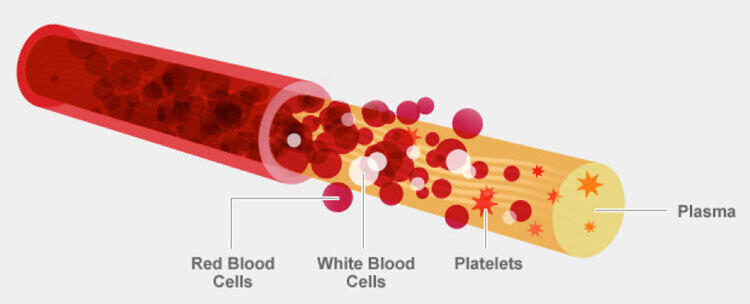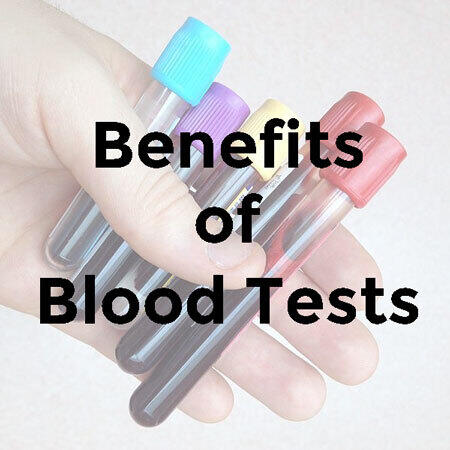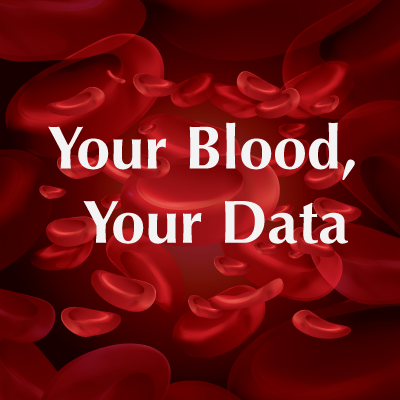
Blood testing is one of the most powerful ways to know about yourself and your health. If you are tracking other aspects of your life, then I recommend tracking your blood too. Blood testing will tell you if you have a disease (or predisposed to one), how your organs are functioning, the effectiveness of medicines, supplements, or fitness regimes, or even if you are pregnant. Blood tests are quite easy and fast, and they provide a wealth of information.
Blood is a bodily fluid that handles several important biological functions. Like checking the oil to know a car’s engine, you can understand the state of your body and its organs by testing and examining your blood and its constituent parts.
While blood testing may come with a periodic medical check-up, they are often reserved for when you have a medical problem and need a more intensive evaluation for a disease. By contrast, I would argue that everyone should get their blood work done regularly and not exclusively when you are sick. Moreover, everyone should gain a basic understanding about what is blood testing and how to read lab results. Your blood tests can help you optimize for wellness and performance. You should consider tracking your results too.
For me, as a self-tracker, understanding my blood and blood testing are logical extensions of a more comprehensive regime to track my health, productivity and life. Blood testing is a form of professional manual tracking. They aren’t hard, but unlike other forms of passive or manual tracking, blood tests require professional equipment, time, and money.
Blood testing can cost as little as 20-50 dollars to several hundred dollars depending on the specific tests. Personally I get my blood tests a few times a year, including at least one comprehensive health panel per year. I use various DIY blood testing services like Life Extension.
Unfortunately, like much of the medical space, blood testing can feel highly professionalized and difficult to understand for the layperson. This is unfortunate since blood testing results shouldn’t be the domain of experts nor exclusively used when you are unwell. In fact, blood tests should be something any health-conscious person can get done regularly and can easily learn to understand.
In this series of posts on blood tracking, I want to look at a range topics related to blood and how it can be used to help self-trackers and people in general understand their health.
Admittedly this is a topic that can get pretty technical. Even getting started tends to unravel into a new vocabulary and obscure acronyms. I’ll do my best to approach an explanation of blood testing step by step and cover the essentials and most useful aspects.
My emphasis is on how to use blood testing as a measurement for getting feedback on your body and yourself. I want to use blood testing as a framework for being “data-driven” in your health decisions and health tracking.
Here is the plan: First, in this post, we will look at why you should do get regular blood tests and some of the basic aspects of blood testing. In later posts, we will be examining some of the best blood tests, how to read your initial results and how to track your blood work over time. While the main focus will be some of the most common blood tests, I will highlight a few specific blood biomarkers and blood tests (like Vitamin D and Homocysteine) that are particularly beneficial. Finally we will look at some resources and steps you might use to create a data-driven process around your blood testing, your health changes and lifestyle improvements.
Let’s get started by looking at what is blood and blood testing.
What is Blood?

SOURCE: https://www.oneblood.org
Your blood consists of cells and lipids.
The average adult has roughly 5 liters of blood, and our blood typically counts for 7% of our body weight. Blood is a bodily fluid whose primary function is to transport to and from the cells nutrients and oxygen as well as remove metabolic waste products. Your blood also detects foreign bodies and handles immunization, delivers messages through hormones, and regulates body temperature.
Blood mostly consists of plasma, which the primary fluid aspect of blood and makes up 54% of the blood’s total volume. Blood also contains a mix of proteins, glucose, minerals, hormones, carbon dioxide and blood cells themselves. Amongst the blood cells, the biggest number are red blood cells (RBCs), which make up 45% of blood. Additionally you have white blood cells (WBCs) and platelets.
What are Blood Tests? Common Biomarkers of the Blood?
Blood tests involve taking out a sample of your blood and then analyzing it in a lab. A blood sample can be extracted either via the vein using a needle or via a fingerpick.
The extracted blood samples are run through biochemical analysis to look at different biomarkers and compared to common reference ranges. They can then be used to understand underlying functions. For example, blood test can help you understand your overall blood health, your metabolism, your liver function, your mineral levels, or various other biomarkers according to the specific tests.

Typical blood tests include a Complete Blood Count (CBC), which measures the percentage of different blood cell types, and a Comprehensive Metabolic Panel (CMP), which looks at different biomarkers related to your metabolism.
There are a lot of different blood tests, and it can get pretty confusing. We will look at many of these tests and biomarkers in detail in future posts.
For now, here are some of the most common biomarkers blood testing can measure: RBC, WBC, Hemoglobin, HDL, Total cholesterol, LDL, Magnesium, Triglycerides, Insulin, and Glucose. With additional blood tests, you can look at other important biomarkers like Cortisol, High Sensitivity C-Reactive Protein, Vitamin D, Creatine kinase, Ferritin, Calcium, Vitamin B12, Folate and Homocysteine.
For a couple of nice videos introducing the most common blood tests, checkout How to Read and Understand Your Blood Test.
How Read Your Results?
Blood testing can seem quite technical and jargon filled. This partly the problem of poor design in how results are presented and also an artifact of medical knowledge being sequestered to medical professionals. As hospitals and treatments get more expensive and disease-focused, it’s important to take health and wellness into your own control.
Reading your lab results isn’t that hard. Your blood test results are first compared to a simple reference range. For example, a blood result is given and then you compare it to a range of results from previous test ranges in general or for that lab. All you need to know initially is if your result falls within the range of normal. If it doesn’t, is it low or high and possibly what does that mean.
Here is an example of from one my most recent blood tests with results and range:

Your results can be further interpreted and read according to past results, recent interventions, and even your family and genetic health history.
Reading your lab results is a key skill to becoming empowered by your blood testing. As such, we will look more into reference ranges and how to read your results in a future post.
If you are looking for a good general introduction to reading your blood work, checkout Dr. Joe Brown’s YouTube Video, “How to Read Your Blood Work and Labs”
Benefits of Blood Testing

Now that we have a basic idea of what is blood, different blood tests and how to read your results according to a common range, let’s examine some of the benefits of blood testing.
1. Blood Tests Are a Reliable Data Point for Your Health and Wellness
The biggest benefit I think for regular blood testing is that it provides a reliable data point for measuring your health and wellness. There is a never ending cycle of so-called what’s best for your health. From superfoods and diets to exercise and everything in between, it can be confusing to know what is best. Fortunately your blood can provide data on your health and wellness. You can then use it to see if there are any issues and optimize for self-improvement.
2. Diagnose Disease
Prevention and early detection are two best ways to deal with any range of diseases, including cancer. Blood tests are not perfect ways to find all diseases, but many diseases can be found via blood tests. Moreover, trends in various blood biomarkers can indicate underlying problems and lead to more tests that do find the problem or disease. No one wants to get a disease, but early diagnosis can make a difference in your treatment and blood tests can provide that information.
One specific example is Prostate-specific antigen (PSA), which is a protein manufactured in the prostate gland in men. Using blood tests, you can check for elevated levels of PSA, which can suggest benign prostatic enlargement, prostate inflammation, or prostate cancer.
3. Check Your Metabolism to Determine If You Are Diabetic or Pre-Diabetic
Diabetes is one of the major health problems facing us individual and as a society. In “The Blood Code,” Dr. Richard Maurer uses blood tests to help us understand our health. As he writes, “your blood tests are a window into your metabolism—the chemical processes of your body.” In the book he goes on to share how certain blood tests can help you understand if you are diabetic, pre-diabetic or have a healthy metabolism. Furthermore, he dives into how various lifestyle interventions like diet and exercise can be implemented to improve your metabolism and how you can use blood tests to track the effectiveness of the treatment.
4. Checking Your Functional Organ Health: Liver
One of the key functions of your liver is breaking down different toxins, drugs and hormone products. Your liver is a kind of detoxification system. Problems in your liver can be seen in your blood tests. Specifically, build up and abnormal levels of protein, albumin, globulin, albumin/globulin ratio, bilirubin, alkaline phosphatase, lactic dehydrogenase (LDH), AST (SGOT), ALT (SGPT), iron, cholesterol, and lipoproteins could all indicate potential problems with your liver.
5. Checking Your Functional Organ Health: Kidney
Your kidneys are part of the urinary system and help regulate your blood. For example, your kidney’s regulate blood pressure, pH level, mineral concentration and water composition of the blood. Your kidneys are responsible for filtering and removing waste (especially urea) from your blood, which, in turn, gets eliminated with water as urine. The health and function of your kidneys can be seen by evaluating your blood and checking blood urea nitrogen (BUN) as well as uric acid, creatinine, BUN/creatinine ratio, sodium, potassium, and chloride ions. By checking your blood, you can see signs of renal failure or poor drug interactions causing kidney issues.
6. Optimal Hormone Levels for Healthy Men and Women
There are several important hormones in our body that regular blood tests can help us optimize. For example some notable hormones are Testosterone, Progesterone, DHEA-S, and Estradiol among others. Yearly blood tests of certain hormones can indicate negatively or positive trending changes as well as provide context for health and wellness problems. For example, research has indicated a relationship between lower levels of bioavailable free testosterone and depression in men as well as correlations with diabetes, heart disease and Alzheimer’s. Unfortunately, if you don’t do regular blood tests, it’s difficult to see your current results in relation to historical hormone levels. So it’s recommended to get these checked yearly.
7. Homocysteine and Risk of Coronary Artery Disease and Stroke
Research has shown that elevated homocysteine levels in your blood indicate a higher risk factor for coronary artery disease and stroke as well as increased depression and increase in bone fractures. During the metabolism of methionine, which can be found in certain foods, an amino acid called homocysteine is created. Using cysteine and other bodily processes and according to availability of certain vitamins and your genetics, your body can normally breakdown homocysteine. If there are issues, your body and blood builds up higher levels of homocysteine. Fortunately by tracking this biomarker, you can take steps to improve your homocysteine level with supplements, medicines or lifestyle interventions.
8. Elevated Inflammation and C-reactive protein
Inflammation is a complex biological process where you body responds to something harmful. The function of inflammation is to remove an injury or damage in the body and its cells. In the short-term inflammation is a normal process, but long-term, elevated levels of inflammation can indicate problems like atherosclerosis, heart disease, arthritis, autoimmune conditions and even cancer. Blood tests looking at C-reactive protein (CRP), a sensitive marker of systemic inflammation, have become increasingly popular. Various studies have shown how CRP can be used as a predictor of coronary heart disease and other diseases of the cardiovascular system. For athlete, especially endurance athletes, C-reactive protein (CRP) has emerged as a test to check on systematic overtraining.
9. Address Small Imbalances Before They Become Large Problems
While blood tests often are used when looking at diseases, I believe the benefit of regular blood tests comes from noticing small changes sooner. Instead of waiting for major issues, your blood tests can indicate small imbalances before they become major issues. You can take steps to manage your health, wellness and performance by leveraging the information your blood tests provide.
10. Your Blood As Your Health Yardstick
By regularly getting blood tests, you can be proactive about your health. You can use your blood tests as a “yardstick” to understand ongoing changes in your blood. Your blood tests provide access to a series of biomarkers that you can use to look at your changes across time. Specifically, according your health history and interventions like fitness, supplements and medicines, you can put changes in context. Your blood tests can help you chart progress. We can go beyond treating disease and optimize for better health and performance. Your blood work can help you take positive steps towards self-improvement. Don’t treat disease. Optimize for health.
Conclusion: Your Blood, Your Data

As a self-tracker and proponent of health empowerment, I look at my blood and blood testing as a method to bring information and data about my life. Your blood is a biological system made of different parts. Blood testing is used to pull out where you fit in a range of other humans. By reading your blood test range, you can see if you are normal or not, and furthermore you can take steps to improve your health accordingly.
Blood and blood testing can seem rather technical. I believe this is a failure of design as well as the entrenched idea of medical knowledge being exclusive for doctors and medical experts. This is changing and more and more companies and consumers are taking ownership over the their medical data and medical knowledge.
I believe we should regularly get our blood work done. It is also relatively inexpensive and easy to do. While it’s not quite as instantaneous or pain-free as other forms of self-tracking, blood testing provides a lot of benefits. Common blood tests can help you understand if you have a disease or optimal metabolism, if your kidneys and liver are healthy, and if your hormones are optimal. Specific biomarkers like Vitamin D, C-reactive protein, and Homocysteine among others are increasingly used by researchers to indicate specific health risks. We, in turn, can use our own levels to fix imbalances before they become diseases or other problems.
Ultimately, blood testing helps know a lot about my individual biological processes and provides a measuring stick. As I make changes in my lifestyle, fitness and diet, I can see how they affect by blood. I can judge the effectiveness of some change by looking at my blood tests.
There is still a lot of ground to cover about blood and blood testing. This first post was largely an introduction focused on the benefits of blood testing and some specific things to look for. In future posts we will be going into more detail on some of this topics, including the best blood tests, reading your lab results and tracking your blood results. I also want to look more at some key biomarkers in the blood. Finally we will return to my main focus which is using blood testing, tracking and data to become data-driven or at least data-informed about our health and lifestyle choices.
While I’m not a medical expert, I’ve come to realize that as a self-tracker, my blood can be another amazing piece of data. It only takes a bit of effort to get tested regular as well as to learn and study what your results me.
Look forward to sharing more soon. Good luck and happy tracking!
